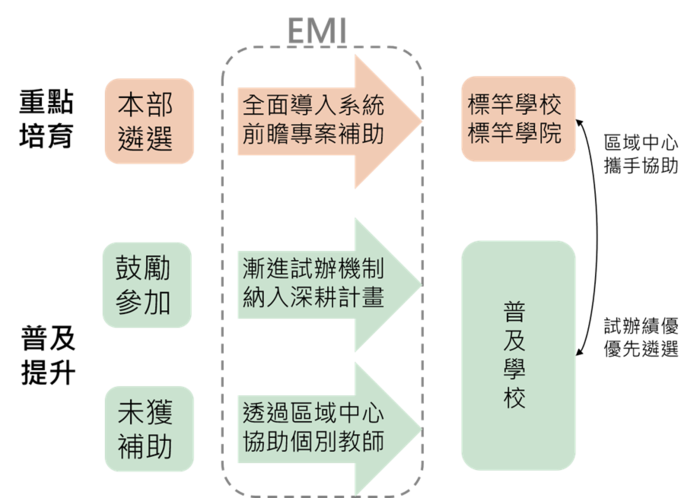雙語化學習計畫(Bilingual Education Project)
壹、關於雙語
因應全球化與國際化的趨勢,擁有與國際溝通的能力已然成為與世界接軌、提升國家競爭力的必備關鍵,而英語為當前全球主要的共通語言,英語力的養成已成為非英語系國家的重視課題。對此,政府致力於提升國民英語能力,透過跨部會研討,積極規劃、推動相關政策,以2030年為目標,將台灣打造為雙語國家,培育雙語專業人才、營造大學國際化環境、推動「全英語授課」(English as a Medium of Instruction,即EMI),深化國家人才與產業的競爭力,拓展國際視野。
1. About bilingual
In response to globalization and internationalization, it is critical to possess international communication skills to raise the country’s competitive edge. Given that English is the predominant global language, developing proficiency in English has become a significant focus for non-English-speaking nations. The government is dedicated to improving the English skills of its citizens. By engaging in discussions across ministries, strategic planning, and the implementation of policies, Taiwan is striving to achieve its aim of becoming a bilingual nation by 2030. This effort involves nurturing bilingual professionals, establishing more international university environments, promoting English as a Medium of Instruction (EMI), boosting the competitiveness of local talents and industries, and expanding global perspectives.
行政院於107年12月通過由國家發展委員會所提出的「2030雙語國家政策發展藍圖」,以「厚植國人英語力」與「提升國家競爭力」為兩大政策目標,透過「從需求端全面強化國人英語力」、「以數位科技縮短城鄉資源落差」、「兼顧雙語政策及母語文化發展」、「打造年輕世代的人才競逐優勢」等四項理念推動雙語政策。不同於以往推動的雙語政策,「雙語國家政策發展藍圖」的特色在於從需求面為考量制定相關措施,由各部會就其業管對象提出方案,積極規劃民眾、產業及政府全面之雙語政策,以提升國人英語力為策略主軸,著重軟體學習與應用環境的打造,盼帶動全民學習英語的風氣。考量雙語國家政策的推動,國發會與教育部協同相關單位共同規劃於110年至113年,以四年100億元推動各項雙語國家策略,結合「教、考、訓、用」四個原則,培養各專業領域的雙語人才,期能讓台灣於2030年成為中英並重的雙語國家,讓下一代更具競爭優勢。
In December 2018, the Executive Yuan sanctioned the "2030 Bilingual Nation Policy Development Blueprint" as proposed by the National Development Council. This blueprint focuses on two primary policy goals: fostering English proficiency among the populace and bolstering national competitiveness. It advocates for a bilingual policy framework based on four key principles:
- Enhancing English skills for all citizens to meet the demand.
- Utilizing digital technology to equalize resources between urban and rural areas.
- Maintaining a bilingual policy while promoting the development of native cultures.
- Providing competitive advantages for the younger generation in talent competitions.
In contrast to past bilingual policies, the "2030 Bilingual Nation Policy Development Blueprint" prioritizes demand-side factors in crafting effective measures. Each ministry is tasked with proposing solutions aligned with its specific targets, with a focus on creating a comprehensive bilingual policy that benefits citizens, industries, and the government. The primary strategy is to enhance the English proficiency of citizens by creating English-friendly environments on campuses and fostering a culture of English learning nationwide. To support the advancement of the bilingual national policy, the National Development Council (NDC) is working with departments within the Ministry of Education to coordinate efforts from 2021 to 2024. A budget of 10 billion NT dollars has been allocated over four years to implement diverse bilingual national strategies. These initiatives focus on integrating teaching, testing, training, and practical application to develop bilingual professionals in different fields. The goal is for Taiwan to become bilingual by 2030, giving equal emphasis to both Chinese and English. This will provide the next generation with a valuable competitive edge.
貳、計畫目標
本計畫以「強化學生英語力,推動全英語授課(EMI),整體提升高教國際競爭力」為願景,針對前述學校、教師及學生面向之問題,將透過協助學校逐步推動全英語教學模式、發展教師全英語教學支持系統、引入具有國外全英語教學經驗之國際教學人員、規劃學生全英語學習認證機制、建置全英語學習環境等措施,以學生為主體,培養學生英語能力,進而提高國際移動力並加值就業競爭力,邁向2030雙語國家。
2. Goals
This plan sets a vision to enhance students' English proficiency by promoting English as the Medium of Instruction (EMI) and thereby improving overall international competitiveness. To address challenges encountered by schools, teachers, and students, the plan focuses on four key initiatives:
1. Supporting schools in gradually transitioning to English-medium instruction.
2. Developing support systems for teachers teaching in English.
3. Bringing in international educators with expertise in English instruction.
4. Implementing certification mechanisms to assess students' English learning and create English-friendly learning environments.
The project aims to cultivate students’ English language abilities, bolstering their global employability and ensuring their competitiveness in the job market, aligning with the national objective of achieving bilingual status by 2030.
參、推動策略
以推動「高教EMI」課程為主軸,在既有推動EMI之基礎下,通盤檢討過去推動實務困境並考量學校推動量能基礎,透過以下四大策略,包括:
策略一「重點培育」:設立標竿學校及標竿學院,期成為各校發展EMI教學之典範學習對象。
策略二「普及提升」:協助非標竿學校或學院,逐步建立校內EMI支持系統及學生英語能力資源體系。
策略三「擴增雙語人才」:延攬有國外全英語授課經驗之國際教學人才,提升學校推動EMI之課程品質與成效。
策略四「資源共享與校際合作」:協助學校延攬人才、發展區域EMI資源中心、全英語授課線上模組課程提供及學分採認機制等全面建構雙語學習環境,逐步提升學生英語力。
3. Strategy Implementation:
The core of our strategy involves the promotion of "Higher Education in EMI" courses. Drawing from past EMI initiatives, we reviewed previous challenges and evaluated the readiness of each educational institution to support EMI programs. Presently, we are pursuing four key strategies:
- Focused Cultivation: involves the establishment of benchmark schools and colleges with the goal of serving as exemplary models for the advancement of EMI teaching practices across different educational institutions.
- Universal Enhancement: involves supporting non-benchmark schools or colleges in developing their own internal systems to support EMI and resources for improving student English proficiency gradually.
- Expanding Bilingual Talents: focuses on attracting experienced international teachers who have previously taught in English-speaking environments to enhance the quality and efficacy of EMI programs in schools.
- Resource Sharing and Inter-School Collaboration: facilitates talent recruitment, establish regional EMI resource centers, offer fully English-taught online modular courses, and create credit recognition mechanisms to build a bilingual learning environment and enhance students' English proficiency over time through inter-school collaboration and resource sharing.
肆、計畫架構
計畫分為「重點培育」及「普及提升」,由台灣已具備雙語教育能量及已有推動實務經驗之大專院校,透過獲重點培育計畫之標竿學校或學院分區設置EMI區域教學資源中心,協助未獲補助學校或資源不足學校推動 EMI課程。透過校際合作,分享課程規劃、教材編撰、教師培力、學生學習、環境建置及行政支援等之實務經驗,提升各校推動 EMI教學之意願,並有助標竿學習及典範移轉,促進台灣英語教育能量流動。
4. Blueprint Architecture
The plan is divided in two categories: Focused Cultivation and Universal Enhancement. Taiwan possesses the capacity to offer EMI courses and boasts colleges with relevant expertise. The implementation of an EMI regional education center within benchmark schools or colleges, as part of the focused cultivation strategy, aims to support institutions lacking financial resources in advancing their EMI education initiatives. Collaboration among schools will enable the exchange of practical insights in curriculum design, textbook creation, teacher development, student learning, environmental arrangements, and administrative backing. These shared experiences are intended to bolster schools' motivation to promote EMI instruction, facilitate the dissemination of benchmark practices, and encourage the adoption of exemplary models, thereby nurturing the proliferation of English education initiatives across Taiwan.
最後更新日期 2024/6/18

